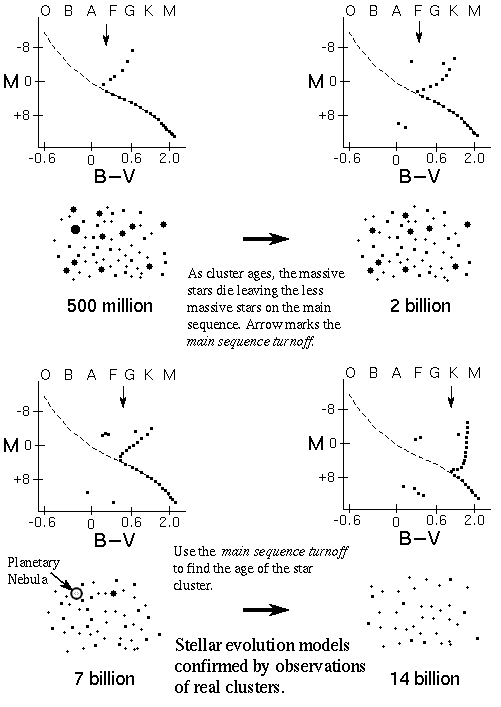
Even the shortest-lived massive stars last longer than the entire span of human history, so how can astronomers test the predictions of their stellar evolution models? In science the sole judge of scientific truth is experiments or observation. Regardless of how nice or beautiful a scientific theory may appear, if it does not make accurate testable predictions, it is invalid. When color-magnitude (H-R) diagrams for star clusters are constructed, there is a convincing confirmation of our stellar evolution models.
What is nice about clusters is that differences in the stars can be explained in terms of only one variable: mass. Stars in a cluster all form at about the same time, so age differences is not a factor in our analysis. The stars form from the same gas cloud, so their chemical composition is the same and all of them are at about the same distance from us (relative to their huge distance from us), so any differences in apparent brightness are due to luminosity differences. More luminous main sequence stars are more massive than dimmer main sequence stars.
Comparison of the theories with reality is easy since you need to only consider how mass affects the cluster stars' evolution. The predictions from the stellar evolution models as to what the characteristics of the stars in different clusters should be are compared with reality. Star formation and stellar evolution models are confirmed by observations of real clusters. By observing clusters of different ages, you can piece together how a star will form, live, and die.


The most massive star still on the main sequence tells us the age of the cluster. That point on the main sequence is called the main sequence turnoff. All stars in a cluster are assumed to have formed at about the same time (observations of current star formation do show that stars form in batches). Stars slightly more massive than the turnoff point have already evolved "away" from main sequence. The main sequence turnoff is analogous to a candle burning—a candle that has been lit longer will be shorter than an identical candle lit more recently.

The age of the cluster equals the lifetime of the stars with masses at the main sequence turnoff.
The most accurate age for a cluster is found from fitting the entire cluster HR diagram (main sequence, sub-giant, red giant, and horizontal branch) to a stellar evolution model of a specific age and chemical composition.
The American Astronomical Society and the Astronomical Society of the Pacific published a beautifully-illustrated guide for teachers, students, and the public called An Ancient Universe: How Astronomers Know the Vast Scale of Cosmic Time. (PDF document: 800 kb in size!) This guide for Teachers, Students and the Public was written by a subcommittee of the American Astronomical Society's Astronomy Education Board. This is a local copy from the AAS Education Board.
![]() Go back to previous section --
Go back to previous section --
![]() Go to next section
Go to next section
last updated: June 24, 2022